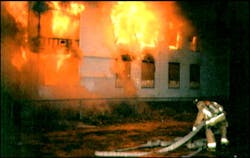Fire Ground Photography
If a picture can tell a thousand words then how many words came out of the dramatic photos that were taken on September 11? If you never had a chance to see the live television coverage of the events as they unfolded, one just has to look at the photos that came from that day to get a sense of the tragedy that took place.
From the first plane crashing into the North Tower to the towers coming down, to the civilians and emergency responders escaping down the surrounding streets, to the aftermath in the subsequent days, it was all captured on film. The now famous photo of the three firefighters raising the American flag over ?Ground Zero?, taken by Thomas Franklin of The Record (Bergen County, NJ), was nominated for but did not win this year?s Pulitzer Prize for Photo Journalism. This would not have been the first time that a fire ground photo had won a Pulitzer Prize. In 1975, Boston Herald-American photographer, Stanley Forman, captured the dramatic attempt of a Boston firefighter attempting to rescue a mother and her baby off of a fire escape, just as the fire escape collapsed. The firefighter was able to grab the rungs of a ladder and hang on but the mother and her baby crashed to the ground. The baby survived the fall but tragically the mother did not.
Fire ground photography is becoming increasingly popular and beneficial to the fire service. Fire ground photos have been used to document fires and tragedies throughout America?s history. Fire departments use photos for investigative purposes, to promote new programs, training aids and to show their members and equipment in action. Many large departments, including Boston, New Orleans and New York City, have established their own Photo Units. Fire service magazines use fire ground photos in advertisements, visual aids to assist with articles and some magazines have sections dedicated to fire ground action shots. Newspapers use fire ground photos to accompany news stories. Fire scene photos can also be found on billboards and other advertising venues. Web sites, solely dedicated to fire ground photography, have brought departments and photographers into a new light. The public is now able to see the dangers that we face every time that we go out the door.
In areas of the country where fires are an unfortunate but frequent occurrence, fire ground photographers have begun to form clubs and associations. These clubs have regular meetings and maintain impressive web sites where members can showcase their most recent work. Many of the photos that we see in magazines come from these organizations? photographers.
In the upcoming weeks and months, we will be discussing various areas of fire ground photography, such as: cameras and accessories, techniques used to take different types of shots, ways to get your photos published, computers and photography and a few unwritten rules that have been learned over the last few years. We will learn that fire ground photography can be fun and rewarding yet at the same time very frustrating. Rewarding when you get the exact shot that you had been waiting for or when you see one of your photos in a magazine or newspaper. Frustrating when you get there one minute too late or when the shot that you thought was going to be great, turns out to be obscured by smoke or not crisply focused.
On a final note, you may have noticed that the two photos that were mentioned with the Pulitzer Prize are not shown. These photos are copyrighted by the photographers and the companies they worked for. It would have been illegal to use these photos without permission from the two newspapers. Copyright law, as it pertains to fire ground photography, will be another topic discussed in a future column.
Related:
